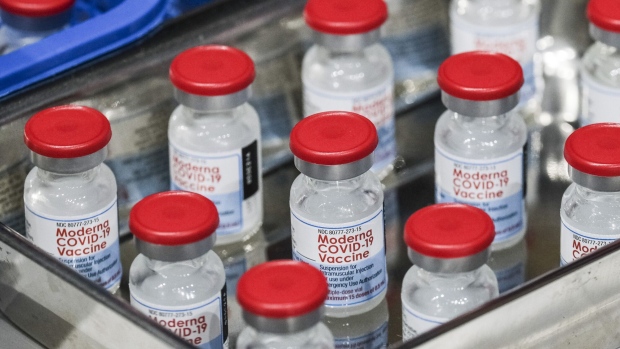Nov 2, 2023
Moderna Reports $3.6 Billion Loss on Covid Supply Writedowns
, Bloomberg News

(Bloomberg) -- Moderna Inc. shares tumbled after the company said it expected revenue to fall sharply next year to well below what analysts were expecting, raising concerns about the company’s plan to pay for its ambitious pipeline.
The vaccine maker sees revenue falling to about $4 billion next year, with sales growth resuming in 2025 as new vaccines hit the market. Analysts were expecting about $6 billion in sales next year.
Moderna also reported a larger-than-expected loss in the third quarter after registering a $3.1 billion charge to write down excess Covid shots and reduce its manufacturing footprint as the vaccine maker prepares for a post-pandemic era.
The writedown caused a net loss of $3.6 billion — much bigger than Wall Street had expected. The company’s sales of $1.8 billion, meanwhile, were above the average analyst estimate.
The shares fell 17% when the US markets opened at 9:30 a.m. Thursday, marking the biggest decrease since November 2021. If this drop holds, it will shed $4.9 billion of market capitalization. Moderna had lost 58% this year through Wednesday’s close.
In a note, Bloomberg Intelligence analysts said the company’s earnings “reflect sluggish Covid-19 vaccine uptake” and that the sales forecast for next year “may widen losses.”
The company is spending massively on research and development to conduct trials of potential new products, and said it expected the spending would rise to $4.8 billion for the full year 2023.
Analysts at Deutsche Bank downgraded Moderna’s stock to a sell rating, citing concerns about the lower sales outlook for next year and the company’s plan to increase spending.
“The empire building leaves increasingly little room for error,” the analysts said.
On a conference call, Moderna said in an investor presentation that it expects its Covid market share in the US to be higher than 2022.
Moderna now anticipates reporting at least $6 billion in sales for the year. That’s the low end of the range that it had previously projected for 2023.
Costs for the quarter included $1.3 billion for inventory writedowns related to excess and obsolete Covid-19 shots, and roughly $500 million charge related to a contract manufacturing wind-down, Moderna said in a statement. The company also reported a $1.7 billion non-cash charge related to a valuation allowance on deferred tax assets. Most of the charges were non-cash, the company said.
“What we really wanted to do was reset the business cost structure to be adapted to where we are going forward,” Chief Executive Officer Stephane Bancel said in an interview. “The world has changed from a pandemic to an endemic” situation, he added.
Since Moderna relied heavily on contract manufacturing during the pandemic, the manufacturing downsizing was largely done by ending contracts with outside contractors and didn’t involve internal job cuts, Bancel said. Moderna expects Covid vaccination rates to be similar to last fall, he added in the interview.
In its statement, the company said it expected the overall US market for fall 2023 will be at least 50 million Covid shot doses. Moderna splits the Covid shot market with its competitor Pfizer Inc.
Dwindling Demand
In recent weeks, the company’s investors had erased billions of dollars in market value after its rival, Pfizer Inc. cut its profit outlook, sounding the alarm on dwindling demand for its Covid shots and pills.
Moderna has been struggling to appease investors now that the emergency phase of the pandemic is over. The company is turning on a firehose of spending to expand beyond Covid shots and develop new vaccines for flu, RSV and cancer, among other diseases. But those products still need to be approved, and developing them will be expensive. The company needs consistent revenue from Covid vaccines, its only commercial product for now, to help fund its ambitious strategy.
Both Moderna and Pfizer have faced challenges with their Covid vaccines this fall. The rollout got off to a rocky start, with some pharmacies canceling appointments due to a lack of supply.
There are also new dynamics at play. Before the Covid public health emergency ended in May, the US government paid for vaccines and allocated them to states, essentially streamlining the process. Now, consumers, retailers, distributors and insurers are for the first time navigating booster rollout in the commercial market. There’s also vaccine fatigue among consumers more than three years after the pandemic began.
Public health experts have been disappointed by the uptake for the Covid vaccines so far. A survey presented last week found only 7% of U.S. adults and 2% of children have gotten new versions of the Covid-19 vaccines.
This story was produced with the assistance of Bloomberg Automation.
(Updates with shares, analyst note starting in fifth paragraph)
©2023 Bloomberg L.P.


